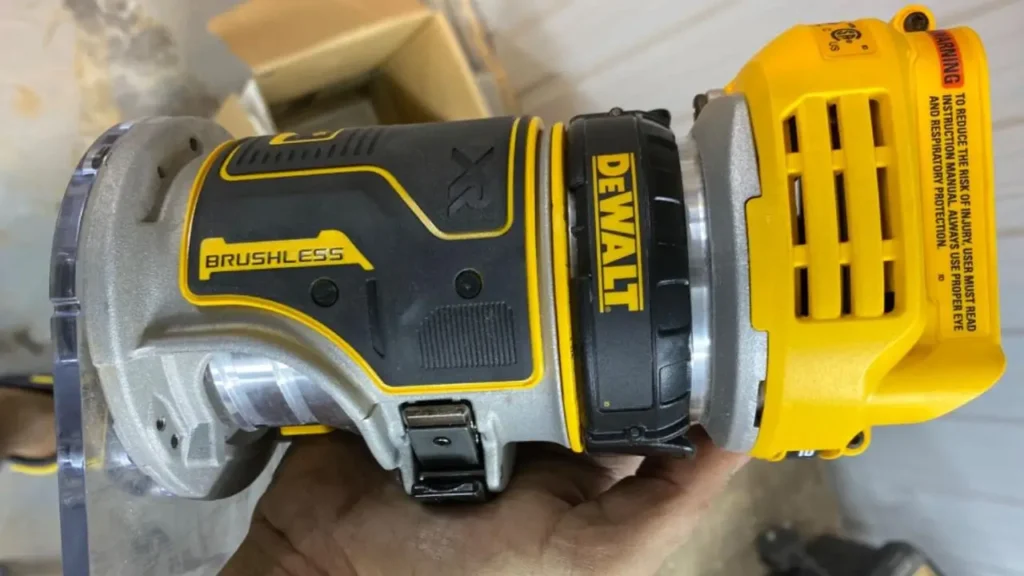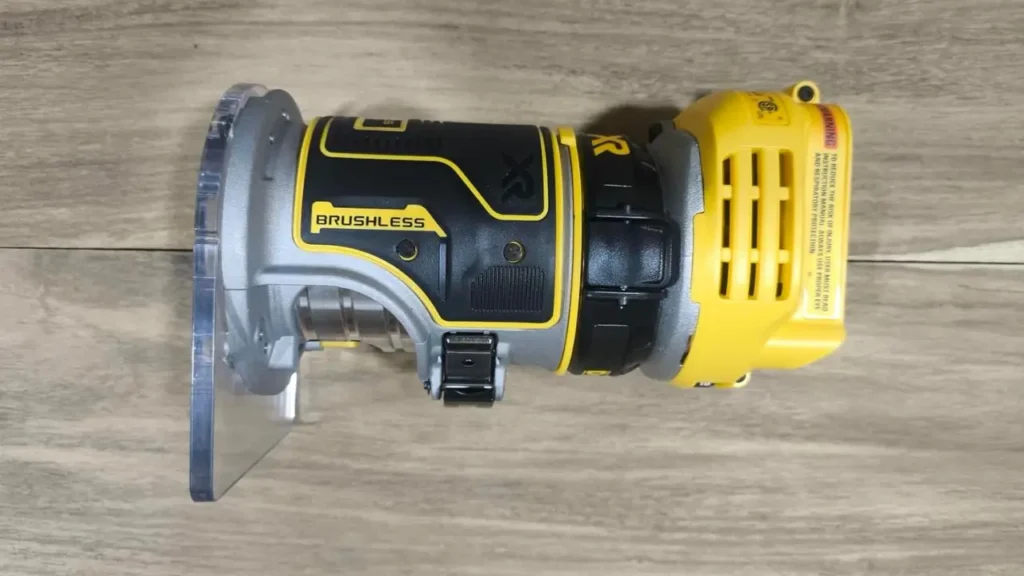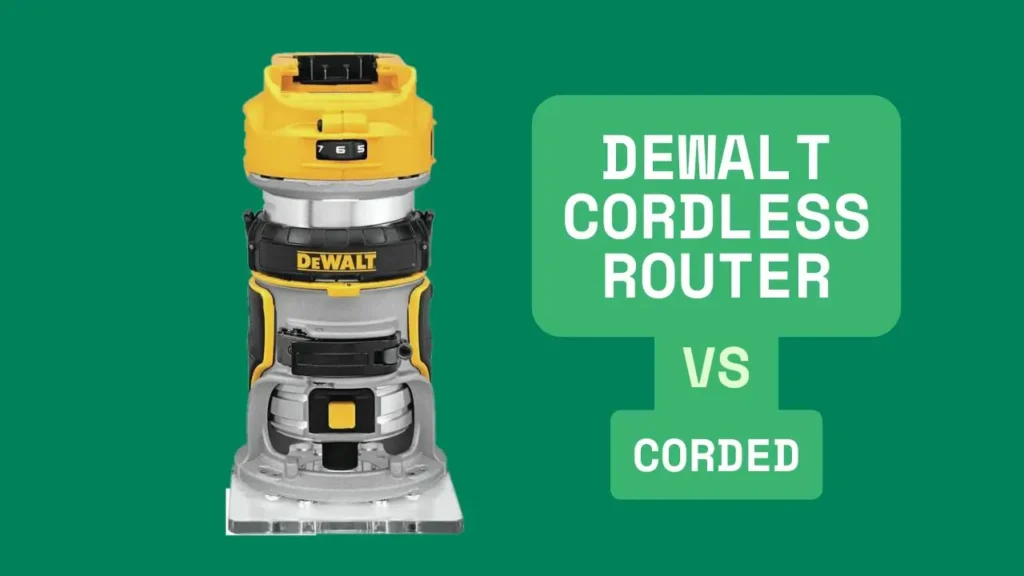Quick Summary: DEWALT Cordless Router vs. Corded: Which One Works Best?
- Content Type: Hand Tested Review
- Last Updated: July 30, 2025
- Fact-Checked By: Azlan - Smart AI Gears Team Member
- Rating: 4.8/5
- Best For: Woodworkers and professionals who prioritize mobility and convenience on the job site.
- What’s Great: Cordless freedom, strong brushless motor performance, and excellent ergonomics.
- What’s Not: Higher price point compared to competitors and slightly lower max RPM than corded.
- Buy If: You need portable power and already own or plan to invest in DEWALT 20V MAX batteries.
- Avoid If: You only work in a stationary shop and prioritize raw power or a lower upfront cost.
- Affiliate Link Present: Yes
- Price at Review Date: $125
- Available At: Amazon
Weighing 4.8 pounds (3.4 pounds without batteries), the DeWalt cordless router defies the usual idea that cordless tools fall short of corded ones. I tested the DCW600 in my shop and saw its brushless motor create smooth and even cuts while reaching speeds of up to 25,500 RPM across seven adjustable settings.
How does the DeWalt DCW600 match up against its corded relatives? It reaches speeds close to the 27,000 RPM offered by DeWalt’s corded version. It cuts out tangle-prone cords and avoids replacing carbon brushes. I found I could run it nonstop more than an hour and still not feel pain in my hand or wrist. This makes it great to trim, shape, or cut materials like wood, plastic, or even metal.
However, with a price tag of $125 just for the tool itself, it costs similarly to other brands like Makita at $129 and Ridgid at $119, making it a competitive option. In this detailed comparison, I’ll walk you through what I discovered after testing both the cordless and corded versions of DeWalt routers. This should help you figure out which one belongs in your workshop.
Disclaimer
Affiliate Disclaimer
I want to be 100% honest with you. Some links you see in my post are ‘affiliate links’. This just means if you click one of my links and then buy a tool, I get a very small money from the shop.
This does not cost you any extra money at all. The price is the same for you.
This small help lets me keep this blog alive and test more tools for you. Please know, I only link to tools I have used myself or received a verified review of the tool and believe are good. My words and my review are my own, nobody pays me to say nice things. Thank you for your support!
Image Information
All product images used in this post are provided by the author and claimed to be their own usage. According to the author, these images are either self-clicked, taken during hands-on testing, or screenshots captured for review purposes. If you believe any image violates your rights, please contact us for proper credit or removal.
Price & Stock Information
The product prices and availability mentioned in this post are accurate as of the time of publishing. However, prices may change on the seller’s website without notice. Please always check the latest price and stock status on the official product page before making a purchase decision.
- Dual LEDs help illuminate the work surface
- Variable-speed dial allows the user to match speed of of the router to the application
- Depth adjustment ring allows for fast and easy height adjustments
What Is the DeWalt DCW600 and Who Needs It?

The DEWALT DCW600 is a powerful, battery powered router for detailed cutting and shaping on wood, plastic and even light metal. Based on the design of DeWalt’s popular corded trim router, the DCW600 packs strong performance into a smaller-sized tool. This 20V MAX XR cordless compact router offers power similar to corded models while freeing you from relying on a power outlet making it an ideal choice to handle professional-level cutting anywhere.
Practical Compact Router for Detailed Trim Work
The DCW600 works great for careful intricate tasks due to its smaller build and lighter feel. Weighing 4.8 pounds with a 5.0 Ah battery (or 3.4 pounds on its own), it does a great job balancing steadiness with ease of use. While it runs a bit heavier than other models, its weight placement feels natural as you use it.
The brushless motor stands out because it avoids the hassle of replacing carbon brushes while also boosting both runtime and motor durability. It offers speeds reaching up to 25,500 RPM with seven marked settings making it handy for various woodworking tasks. Features like electronic speed control soft start, and an electronic brake add safety and improve precision during operation.
Cordless Design to Move
Not being tied to a cord is one of the DCW600’s biggest perks. This tool works well on jobs where movement is important, like trimming cabinet edges at a job site or working on items that can’t be taken to a fixed router.
Two LED lights brighten up the workspace well, which I like when I’m working in darker spots or under cabinets. The cutout design also offers a clear view around the bit making it easier to keep cuts precise no matter where you’re working.
Works with DeWalt 20V Max Batteries
The DCW600 runs on DeWalt’s large 20V MAX battery system. This gives good flexibility if you’re already using those batteries. While testing, I saw great runtime when using bigger capacity batteries. A 5.0 Ah battery can run this tool a long time during routing, though it’s smart to keep extra batteries around if you’re working all day.
To handle smaller tasks where easy movement is a priority, the DCW600 works well with the compact 3.0 Ah battery. This battery gives 33% more runtime than older 18-volt ones while weighing 22% less compared to bigger battery packs.
The bare tool costs $125, which makes it a very attractive option for people already using the DeWalt battery system or experts who need a cordless option that still delivers solid performance.
Cordless or Corded: Performance Face-Off
From my side-by-side testing, the gap in performance between corded and cordless routers is shrinking. Real-world tests show how the DCW600 reflects this step forward with noticeable results.
Comparing Speed and Torque
The brushless motor in the DeWalt cordless router provides strong performance. It spins at speeds from 16,000 to 25,500 RPM across seven settings marked for adjustment. While this speed is lower than DeWalt’s corded router, which spins at 27,000 RPM, I noticed it affects cutting speed rather than the quality of the cuts. You just need to work a little slower and more .
When lining it up against others, the DCW600 operates at lower speeds than Milwaukee’s M18 Fuel with 31,000 RPM and Makita’s cordless model at 30,000 RPM. Still, its power held steady even when cutting tougher materials. The variable speed dial keeps the RPM stable no matter how hard the material is.
Precision Cutting on Hardwoods
I tested the DCW600 on both pine and oak, and it carved edge profiles that were as clean and exact as work done by larger routers. It handled dense woods like cherry and maple without losing performance, thanks to adjustments at slower speeds.
Using bearing-assisted bits to shape edges felt just as smooth as with corded routers. I had doubts about its ability to handle template routing at first, but the cordless DCW600 exceeded my expectations. Though, it needed a bit more patience compared to faster models.
Differences in Handling and Control
With a 5.0 Ah battery, the DCW600 weighs 4.8 pounds, or 3.4 pounds when used without a battery. This router leans more on the heavy side compared to some cordless options. Many users mention it feels unbalanced with bigger batteries, and say smaller ones make it easier to handle.
This router comes with a thicker handle than others in its class. The rubber surface wrapped around the base helps users hold it better paired with padding that stops it from sliding and lowers vibration. It also has a quick-stop feature that halts the bit when switched off. This adds extra safety, which many corded models don’t offer.
User Experience: Comfort, Adjustments, and Accessories

Ergonomics plays a huge part in how comfortable a router feels to use. The DCW600 was designed with many features that make it easier to handle for long periods.
Depth Adjustment Ring Compared to Thumb Screw
DeWalt uses an adjustment ring system that’s different from the common thumb screw designs other cordless routers use. The DCW600 has a quick release lever lock paired with an adjustment ring to change depth. You open the clamp and just twist the ring to set the depth you want. The adjustable depth gauge lets you zero the bit after installing it so you don’t need extra math when cutting grooves or dados. However, making bigger depth changes takes more time compared to other systems since you have to turn the ring several times to get where you want.
LED Lighting and Visibility
The DCW600 includes dual LED lights that brighten up the space around the bit. Its large cutout design improves how much you can see while working, which makes it handy when lighting is poor. However, attaching the dust collector reduces visibility because it blocks both the light and your line of sight. This balance between collecting dust and being able to see is one of the rare downsides of the DCW600.
Handle Comfort and Usability with One Hand
With the 5.0 Ah battery attached, the router weighs 4.8 pounds, or 3.4 pounds without the battery. This makes it one of the heavier cordless options out there. The handle has a thicker diameter compared to some other brands, which might not feel as comfortable for people with smaller hands. Users say its lightweight design allows them to operate it with one hand while holding workpieces steady with the other.
DeWalt Cordless Router Accessories Breakdown
The DCW600 works with a great variety of accessories, including:
- The DNP612 Plunge Base allows more flexibility with different cutting tasks.
- The DNP615 Dust Adapter helps keep your workspace cleaner.
- The DW6913 Edge Guide makes straight-line routing easier.
- The DNP616 Dust Collection Adapter is made to work with the plunge base.
- Options include a round sub-base or a fixed base.
These add-ons turn the compact router into a more adaptable tool system that can handle a variety of unique routing tasks.
Price and Value: Should You Go Cordless?

Choosing between a corded and cordless model often depends on how much you’re willing to spend. Let’s take a closer look at the costs involved with getting started.
Bare Tool vs Kit Costs
The DCW600 bare tool costs about $125. Among leading competitors, this makes it a highly competitive option, often matching or even beating others on price. The plunge router model DCW620B, is priced at $332. Promotions sometimes offer better deals. Home Depot might sell bundles that include a charger and 6Ah battery for around $125 – $199, which could match the bare tool’s cost or offer significant value.
Battery and Charger Pricing
If you’re not already using DeWalt products, you’ll want to think about battery expenses. A pair of 5.0Ah batteries with a charger costs $279, though it’s common to see deals dropping the price to about $265. These batteries work with all 20V MAX tools and come with LED indicators to show charge levels.
Warranty and Service Plan
DeWalt offers solid protection for buyers with their tools. They include a three-year limited warranty, a year of free service, and a 90-day money-back guarantee. This warranty covers issues caused by defects in materials or how it was made, but it’s valid when bought through authorized sellers.
Price Comparison with Milwaukee and Makita
The difference in price becomes clear when looking at different brands. Makita’s cordless router goes for $129 as a bare tool, the same price as Ridgid’s, while Milwaukee’s option is priced higher at $179. Ryobi stands out as the cheapest choice at $69. This means DeWalt’s model is now very closely priced to Makita and Ridgid, making its performance and features even more appealing at this competitive price point.
Conclusion
After thorough testing, the DeWalt DCW600 cordless router manages to close much of the performance gap between corded and cordless tools. Its brushless motor achieves solid performance reaching speeds of 25,500 RPM. While this falls short compared to the 27,000 RPM of its corded counterpart, it affects how you can cut rather than the quality of the work. You might just need a little more time while using it.
The lack of cords stands out as the strongest reason to pick this model. I noticed during my time with the DCW600 that it works great in tasks where moving around is essential. Trimming cabinet edges on-site or handling pieces too big to bring to a stationary router felt easy with this tool. The bright dual LED lights and wide cutout design really help in making things more visible, but this advantage drops off when you attach the dust collector.
The price point is now highly competitive. At $125 for just the tool, it closely matches competitors like Makita and Ridgid, which are also priced around $129. This tool’s value is now even clearer for those who are already using DeWalt’s 20V MAX batteries or to professionals who want cordless freedom without losing out on performance, at a very reasonable cost.
The weight feels well-balanced while using it even though it is a bit heavier than some other models. At 4.8 pounds with the battery, it offers a solid mix of steadiness and ease of handling. The adjustment ring system and quick release lever lock give it an edge over traditional thumb screw setups in most other routers.
Key Takeaways
Here’s what stood out after testing both DEWALT’s cordless and corded routers:
• Speed Gap Shrinks: The DCW600 cordless router spins at 25,500 RPM compared to the 27,000 RPM of its corded version. It cuts almost as cleanly but at a lower pace.
• Freedom Over Raw Power: Cordless tools shine for tasks like cabinet trimming and on-the-go work. Corded routers still fit better in stationary workshop settings.
Competitive Cost for Convenience: The DCW600 is priced at $125 for the bare tool, making it highly competitive with other popular brands. It offers excellent value, especially if you already own DeWalt batteries.
• Weight Distribution is Key: Even at 4.8 pounds with a battery, the balanced design makes it easy to handle with one hand even for longer use.
• Big Deal for LED Lighting: The dual LED lights and large cutout design help users see better. However, the dust collection attachment can get in the way of this benefit.
The cordless DCW600 now gives professional-level results like corded ones. Deciding on it comes down to your work habits instead of how well it performs. Woodworkers who need portability and use DeWalt’s batteries may find the higher cost makes sense.
FAQs
- Q1. How does the performance of cordless routers stack up against corded ones? Cordless routers are catching up to the performance of corded models. The DeWalt DCW600 cordless router runs at 25,500 RPM, which is close to the 27,000 RPM of the corded version. This small variation slows the cutting process a little but doesn’t change the quality so you just need to work a bit slower.
- Q2. What are the main advantages of using a cordless router? Cordless routers offer better mobility and eliminate the hassle of power cords. You can use them in places where there are no nearby outlets. They work well for tasks like trimming cabinet edges or dealing with projects that are hard to move to a fixed router station.
- Q3. Is the DeWalt DCW600 cordless router a good buy? The DeWalt DCW600 works great if you care about both portability and power. It costs $125 for just the tool, offering excellent value with solid cutting performance, great features, and runs on the DeWalt 20V MAX battery system. It’s a smart pick, especially if you already use other DeWalt tools.
- Q4. How does the DeWalt DCW600 handle visibility during operation? The DCW600 comes with two LED lights and a large cutout that improve visibility near the bit. These features are helpful when working in lit areas. But attaching the dust collector might reduce some of the visibility benefits.
- Q5. What is the weight and ergonomics like on the DeWalt DCW600? DeWalt DCW600 weighs 4.8 pounds when paired with a 5.0 Ah battery and 3.4 pounds without it. It’s a bit heavier compared to few competing models, but its weight feels well-balanced during use. The design helps provide stability. You can control it with one hand even when using it for long stretches.




